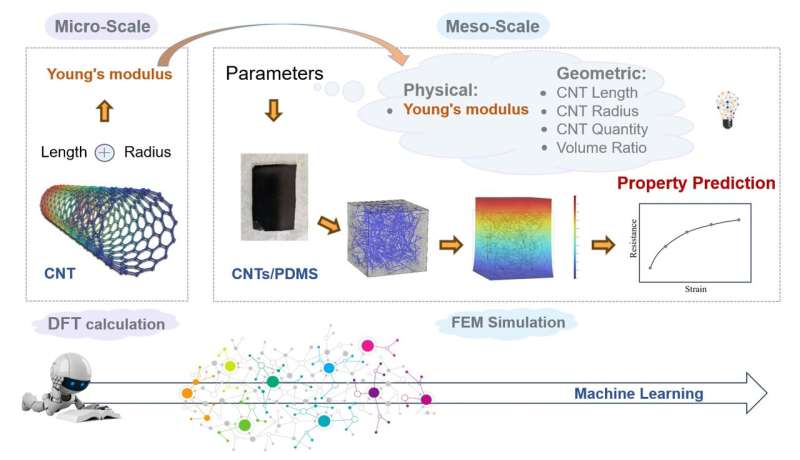
The integration of microscale and macroscale simulations has long been a computational challenge in material science. Addressing this, researchers have developed AGAT, a machine learning model that efficiently predicts the behaviors of materials used in wearable electronics, particularly focusing on CNTs/PDMS composites.
The AGAT model was established based on the architecture of artificial neural networks (ANN) embedded graph attention networks. The embedded ANN layer, which was used to predict Young’s modulus from the length and radius of the CNT, serves as a bridge between the molecular model and the mesoscale model.
Utilizing data from extensive multiscale simulations and existing literature, the model has been trained to assess the material sensing properties of CNT/PDMS composites with high precision.
The AGAT model offers a significant reduction in computational overhead of material properties essential for flexible electronic devices. By bridging the gap between detailed molecular simulations and practical macroscale applications, the model enables designers to explore new materials and optimize them for electronic interfaces with high efficiency.
The findings are published in the journal National Science Open. The research was led by Prof. Xiaonan Wang and Dr. Lingjie Yu.
More information:
Lingjie Yu et al, A machine-learning-enabled approach for bridging multiscale simulations of CNTs/PDMS composites, National Science Open (2024). DOI: 10.1360/nso/20230055
Science China Press
AI approach enhances efficiency of material multiscale simulation for wearable electronics (2024, May 6)
retrieved 6 May 2024
from https://techxplore.com/news/2024-05-ai-approach-efficiency-material-multiscale.html
part may be reproduced without the written permission. The content is provided for information purposes only.

The integration of microscale and macroscale simulations has long been a computational challenge in material science. Addressing this, researchers have developed AGAT, a machine learning model that efficiently predicts the behaviors of materials used in wearable electronics, particularly focusing on CNTs/PDMS composites.
The AGAT model was established based on the architecture of artificial neural networks (ANN) embedded graph attention networks. The embedded ANN layer, which was used to predict Young’s modulus from the length and radius of the CNT, serves as a bridge between the molecular model and the mesoscale model.
Utilizing data from extensive multiscale simulations and existing literature, the model has been trained to assess the material sensing properties of CNT/PDMS composites with high precision.
The AGAT model offers a significant reduction in computational overhead of material properties essential for flexible electronic devices. By bridging the gap between detailed molecular simulations and practical macroscale applications, the model enables designers to explore new materials and optimize them for electronic interfaces with high efficiency.
The findings are published in the journal National Science Open. The research was led by Prof. Xiaonan Wang and Dr. Lingjie Yu.
More information:
Lingjie Yu et al, A machine-learning-enabled approach for bridging multiscale simulations of CNTs/PDMS composites, National Science Open (2024). DOI: 10.1360/nso/20230055
Science China Press
AI approach enhances efficiency of material multiscale simulation for wearable electronics (2024, May 6)
retrieved 6 May 2024
from https://techxplore.com/news/2024-05-ai-approach-efficiency-material-multiscale.html
part may be reproduced without the written permission. The content is provided for information purposes only.











